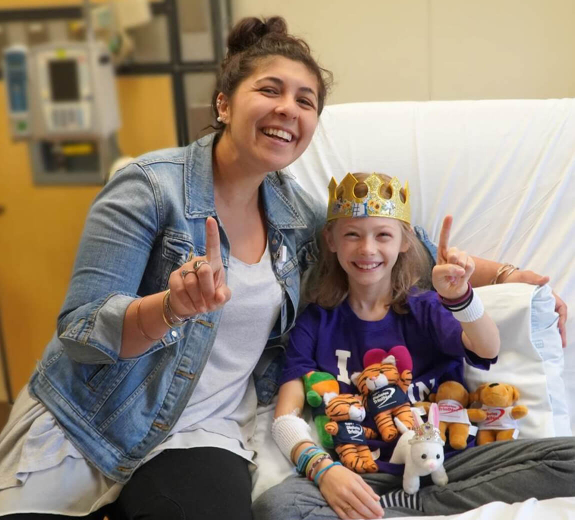Getting Involved in Clinical Research
The Brooke family learned about BRI when their son Andrew was diagnosed with T1D in 2015. Andrew’s doctors recommended the rest of the family get tested — and found Zoe had a nearly 100 percent chance of developing T1D. Zoe was invited to participate in a BRI study monitoring people like her.
“As parents, we were excited because this turned a difficult diagnosis into an opportunity and would teach us a lot about her health,” says Zoe’s mom, Kari. “But we wanted this to be Zoe’s decision.”
Kari and her husband, Michael, broke down clinical research into kid-sized pieces: they told Zoe that about two-thirds of participants would get medicine that would likely keep them healthier. One-third of people wouldn’t get the medicine, but Kari and Michael explained that this is very important because it helps scientists know if the medicine is working. Zoe would need to travel to Seattle and miss some school. But everyone who participates helps scientists find better treatments for T1D.
“Zoe looked at us and said ‘You’re telling me I have a two-thirds chance of helping me, and a 100 percent chance of helping everyone? I’m in,’” Kari says.
Zoe first participated in the TrialNet Natural History study for three years beginning in 2016. In May 2019, when she received the T1D diagnosis she knew was coming, BRI’s team let her know that as a newly-diagnosed child with T1D, she qualified to participate in the PROTECT study. Zoe became the first participant to enroll at the BRI site. As part of her participation, the BRI team helped her learn to live with the disease — including teaching her about monitoring blood sugar and playing a game to track how many carbohydrates she eats.
“I was the first to sign up, so Anna made me a crown,” Zoe says. “I want to help people from all around the world, so if they get diagnosed they don't have to be as scared. I’m helping people get closer to a cure, and that makes me feel great.”
Support From A Distance
Though visits to BRI were canceled, Anna’s team still supports research participants like Zoe: They monitor glucose remotely and check-in via call, text and video chat.
“Anna regularly asks if I have questions about Zoe’s blood sugar or if I need support,” Kari says. “As a parent of two 10-year-olds with type 1, that’s an incredible resource.”
The impact this work has on Zoe is apparent in her toy collection, and in her future intentions: Some of her stuffed animals are named after BRI’s team, including a tiger named after Anna and a turtle named after Sandi Lord, MD, a BRI clinical research physician. Zoe has also collected a variety of nursing supplies and often does pretend blood draws on her mom and members of the BRI team.
“Anna teaches me stuff and lets me help take my temperature,” Zoe says. “They gave me a badge that says Zoe Brooke, Junior Nurse. And I want to be a real research nurse when I grow up.”
Built-in Resilience
On top of training Zoe as a junior nurse and supporting many other research participants, Anna manages her own T1D. She’s also one of a handful of BRI nurses spending extra hours helping Virginia Mason, BRI’s medical partner, field calls from people who have COVID-19-like symptoms. Living with T1D, she says, has equipped her to adapt to this new normal.
“Diabetes teaches you to live with the unexpected — we’re used to constant change,” she says. “People with chronic illness have this built-in resilience, and we can really tap into that in moments like this.”
Zoe is living proof. She has some advice for people, with and without T1D, to get through the COVID-19 pandemic and other difficult times.
“I get scared of needles — and since I’m in a research study, I have needles poking me all the time,” she says. “But I’m getting less scared and I know that I’m helping people. I feel happy because I know that I can have a challenge in my life and I can get through it, even if it's hard, or scary, or other people thought I couldn’t. When the world tries to push you down, keep your head up and keep moving forward.”




